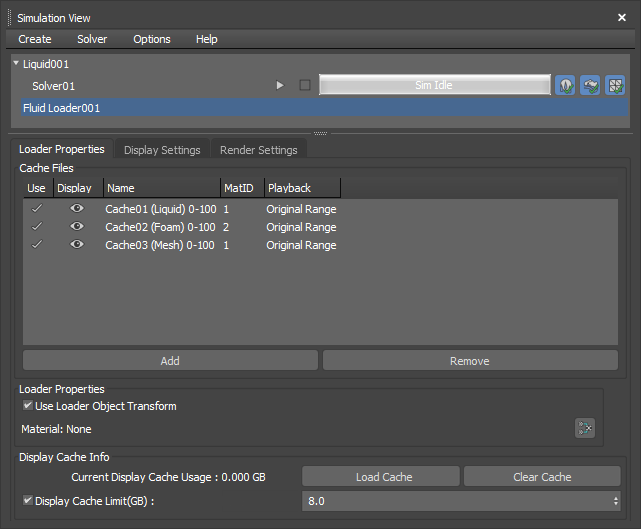Use the Loader Properties panel to change settings for any existing Fluid Loader objects.
-
Note: You must select a Fluid Loader object in the Management System area for the panel to appear.

Cache Files area
- Use
- Enables the Fluid Loader object in the simulation.
- Display
- When enabled, displays the cached simulation in the viewport. You can disable individual caches to increase performance without affecting the rendered result.
- Name
- Displays the name and type of the cache.
- MatID
- Shows the current Material ID.
- Playback
- Shows the current playback method.
- Add button
- Adds a new Bifrost data file to the currently selected fluid loader.
- Remove button
- Removes selected cache files from the currently selected fluid loader. You can hold Ctrl or Shift to select multiple cache files.
Cache Files area context menu
Right-click an entry to open the menu.
- Enable
- Enables the fluid loader object in the simulation.
- Display
- When enabled, displays the cached simulation in the viewport. You can disable individual caches to increase performance without affecting the rendered result.
- Rename
- Lets you change the name of the cache file.
- Remove
- Removes the cache files from the Fluid Loader object.
- Open cache location in Explorer
- Opens a window in Explorer with the cache location.
Loader Properties group
- Use Loader Object Transform
- When using transforms on the object, offsets all cache files referenced within the loader so that you can move or scale without having to re-simulate.
- Material
- Shows the name of the material assigned to the loader.
- Material Editor button
- Opens the material editor where you can select a material for the Fluid Loader object.
Cache Properties group
Note: You must first select a cache file for these options to appear.
- Material ID
- Sets the Material ID for the currently selected cache.
- Cache Playback
- Sets how to play back the cache:
Original Range Uses the original frame range. Custom Start Sets a custom start frame. Custom Range Sets a custom range. Shorter ranges than original will speed up the simulation while larger ranges will slow it down. Note that if you slow the simulation down, you may experience dropped frames because there is no longer correct interpolation. Playback Graph Animates which cache frame is played at any given time. For example, if you record a cache from frames 0 to 100 and then want it to play back twice as fast forward and then in reverse, choose this option, turn on Auto Key, set the Frame parameter to 0.0 at frame 0, 100.0 at frame 50, and then back to 0.0 at frame 100. The function curve in Track View shows how the cache is played back. - Cache Path
- Shows the file path for the cache. You can also right-click the path and open the cache location in Explorer.
Display Cache Info group
- Current Display Cache Usage
- Shows the cache usage of the selected fluid loader.
- Load Cache button
- Loads the viewport cache to memory. When clicked, a progress bar and a cancel button will appear at the bottom of the Max interface.
- Clear Cache button
- Clears the viewport cache from memory.
- Display Cache Limit (GB)
- When enabled, sets the amount of memory allocated to viewport caching of the simulation. When disabled, no limit is placed on the display cache memory usage. Changing the Display Cache Limit settings can be particularly useful when working with heavy simulations requiring large amounts of memory.
- Cache Limit
- Sets a cache limit, with a default setting of 8.0 GB and a minimum setting 0.5 GB. Right-click to copy and paste values, select all, or set the minimum and default values.
